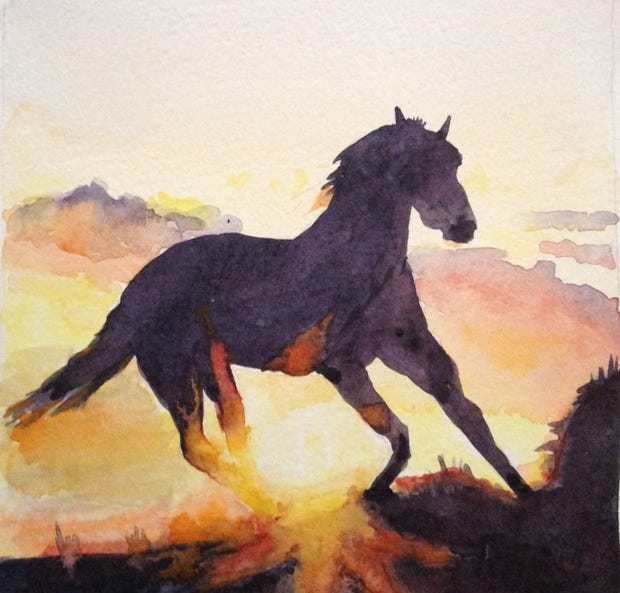Choose joy while allowing room for sadness
Considering St. Francis' famous prayer, line by line
Where there is sadness, joy.
A child has no idea of the burdens or shadows a parent or family or culture expects her to carry. I was always sensitive, absorbing the emotions of others, too thin-skinned to resist. Too naïve to know I had a choice. And so I developed a long habit of avoiding gloomy, negative people; I didn’t want to be pulled down into their misery. It was years into adulthood before I realized that their melancholy mirrored my own. I thought I was resisting them, but it was really myself.
Early on, probably through parental influence, I developed a coping strategy of talking myself out of feeling sad. After all, what did I have to be sad about? I have a roof over my head, clothing, food, a good education—the list of privileges is long. But that futile exercise only made me feel guilty for feeling sad. It certainly didn’t make me joyful.
The poet Rilke was famously melancholic. He offers this wise view of sadness as an energy to be respected, even embraced, for its transformative power:
“[I]f only it were possible for us to see farther than our knowledge reaches, and even a little beyond the outworks of our presentiment, perhaps we would bear our sadnesses with greater trust than we have in our joys. For they are the moments when something new has entered us, something unknown”1
Of the four temperaments, I tend to swing between choleric and melancholic.2 Think Rabbit and Eeyore in the Winnie the Pooh stories. I’ll admit, I envy Tigger’s high energy and Pooh’s unambitious contentment. Joyful people are magnetic, irresistible; their presence lights me up. To be honest, Rabbit is annoying and Eeyore’s just a downer.
American culture in general can be quite negative, gloomy, and critical. It’s hidden beneath a superficial layer of influencers and trivial TV, but, as I wrote earlier about hope, true happiness tends to be viewed with suspicion.
I was raised to slog through my daily duties, and only then, at the very end of long lists and long days, allow myself a bit of fun and enjoyment. The idea that the whole day’s work could itself be sourced in joy was never considered. That it sometimes happened was an accident. But consider this: joy can come first, not to supplant sadness but to balance it. To paraphrase the maxim about peace:
There is no way to joy. Joy is the way.
It’s such a relief that brilliant writers like
are out there, bringing joy to climate action. “Choose Joy” is one of her eight ways to love the future:“There are so many things that need to be done — don’t pick something that makes you miserable! It’s imperative to avoid burnout, so choose what enlivens and energizes you. Take climate change seriously, but don’t take yourself too seriously. The work can and should be gratifying and punctuated with joy.”3
We’ve created a world for ourselves that both mocks and avoids sadness, while treating joy as trivial and naïve. It takes courage to swim against that tide and instead embody joy. Not to elevate it as a superior replacement emotion, but to admit that there is room for both sadness and joy in the natural order of things. I can respect sadness and choose joy, both.
Today, I’ll embody this pair of opposites by bringing joy to my interactions. I’ll allow myself to feel the sadness out there, and within my own heart. I’ll recognize that being wired for sadness makes me reactive to the people around me, taking care not to push sadness away but to make space in my heart for it—and for them, as they are.
The previous line of the prayer, Where there is darkness, light, is here.
Start at the beginning of the series:
If you enjoyed this post, a lovely ❤️ keeps me going. Another way to show love is to share this post with others by restacking it on Notes, via the Substack app. Thanks!
From Letters to a Young Poet
Here’s a website describing the four temperaments.
From her post, What if we act as if we love the future?





I enjoyed this. I have adopted Tigger in the form of an Irish Setter puppy girl. My dog Happiness died unexpectedly in May--you mentioned sadness and I let myself grieve. However I realized I need a dog in my life, so ... she's 3.5 months old now. What do you name a dog that comes to you after Happiness the Irish Setter left without warning. Joy. I named her Joy.
Certainly you’ve read this poem by Camus, but these lines floated through me as I read your beautiful meditation on joy and sadness.
“In the midst of winter, I found there was, within me, an invincible summer.
And that makes me happy. For it says that no matter how hard the world pushes against me, within me, there’s something stronger – something better, pushing right back.”